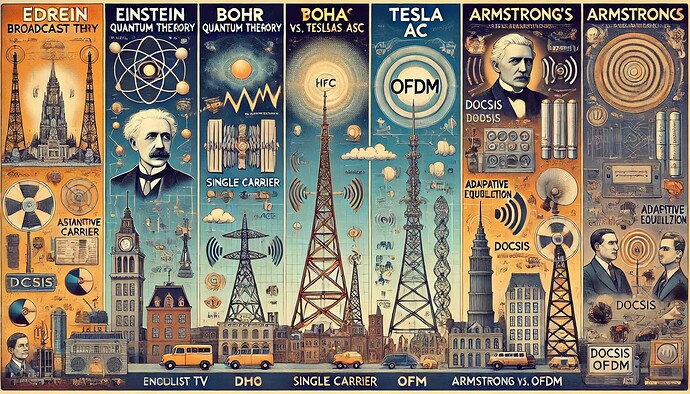A number of interesting technical dispute have occurred over history.
Einstein vs. Bohr on quantum theory. Edison’s DC vs. Tesla’s AC. Sarnoff’s AM vs. Armstrong’s FM.
Single carrier vs. OFDM in broadcast TV, cellular radio, and HFC is another.
Broadcast TV:
The US ATSC went with 8VSB while Europe went with COFDM.
The thinking went like this.
In Europe imagine small isolated hamlets in the valley that cannot be covered with a single high power transmitter. COFDM allowed for a single frequency network with multiple low power transmitters. Homes with coverage from more than one transmitter used a guard interval to prevent inter-symbol interference when hit by the signal from more than one transmitter.
In the US imagine a city and surrounding suburbs and small rural towns all covered with a single high power transmitter on a thousand foot tower covering a 30 mile radius. The 10 dB peak to average ratio of OFDM and the wasted guard interval added too much cost and power consumption to the high power transmitter.
After the ATSC and DVB-T standards were adopted, a US broadcaster conducted tests showing that COFDM worked better than 8-VSB.
OFDM with guard interval can prevent inter-symbol interference from multipath without any knowledge of the impulse response.
Single carrier adaptive equalization can work but only with knowledge of the impulse response which is not a constant over time.
Cellular radio:
3G WCDMA was the last gasp of single carrier in cellular radio before 4G LTE went OFDM.
WCDMA used a variable spreading factor.
-
With a spreading factor of 16 the signal was very robust.
-
With a spreading factor of 1, pure single carrier, the data rate was very fast.
Take your pick, fast and finnicky or slow and robust. I remember standing at close line of sight in the main beam of a one-hundred-foot cellular tower trying to get the UE to go to spreading factor 1 and 16-QAM for the highest data rate. I had to position the UE just right and keep it totally still. Any little movement would increase the spreading factor and lower the data rate.
HFC:
HFC introduced OFDM with DOCSIS 3.1. DOCSIS 3.0 and earlier used single carrier and adaptive equalization. DOCSIS 3.1 learned some lessons on early versions of OFDM over HFC by adding such features as LDPC and multiple modulation profiles.
There are other examples with the common thread being that the magic of OFDM is being able to prevent inter-symbol interference from multipath without knowledge of the channel impulse response.
There are lessons to be learned in modern Wi-Fi, notice that MU-MIMO and even SU beamforming may work well under static conditions but degrade quickly with even slight movement.
David Urban
LinkedIn (and Source): ![]()
